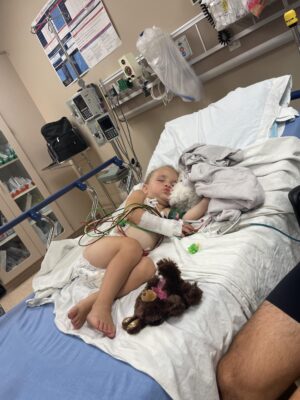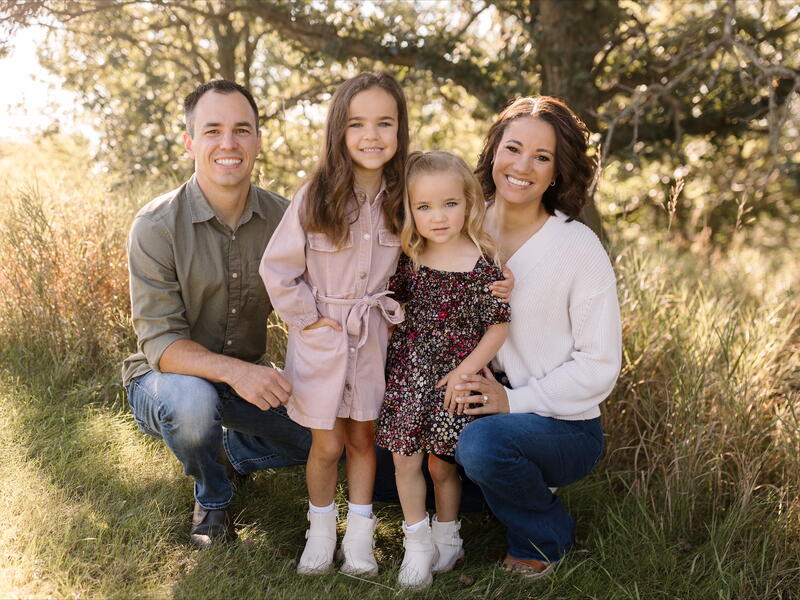Like many parents, Britton and Trever Stoffel have learned how to care for their 3-year-old daughter, Collins.
More specifically, they’ve learned how to handle instances where Collins develops a fever, possibly shaking or convulsing and throwing up – common symptoms of a febrile seizure.
“I didn’t really know it was a thing before it happened the first time,” said Britton. “Hearing from another family that it happened to them and feeling like, ‘Oh gosh, that’s kind of scary.’ And then it happened to us.”
Zach Nolz, M.D., a family medicine specialist at Sanford Health in Luverne, Minnesota, said some of the fear for parents comes from the symptoms from these seizures.
“They’re going to have loss of consciousness. They’re going to have full-body movements,” he said. “Kids, when they come out of it, may be a little groggy for a short period of time, but generally, they return to their normal baseline and have no issues from there.”
Fevers and full-body shakes
Febrile seizures occur due to an acute spike in fever. They’re common for children between the ages of 6 months to 5 years old. Roughly 5% of children will experience one of these types of seizures, typically when exposed to a virus or bacterial infection.
“Typically, we’d see full-body tonic-clonic movements, contracting and extension of all the muscles within the body,” said Dr. Nolz, adding that family history can also play a role. “These are very short-lived. They only last a minute or two before resolving.”
Collins experienced two febrile seizures by the age of 2. Although both were onset by a fever, each seizure presented different symptoms.
The first started with a urinary tract infection and a fever that developed in the afternoon, leading to full-body shakes in the evening.
It was the Stoffels’ first experience with febrile seizures, but not their first exposure.
“Two weeks prior, we had been with friends at the lake, and they had told us about some of their friends and other family with small kids who had just had this happen. And I’d actually had a coworker whose child had had the same thing happen that summer,” said Britton. “Right away, I was like, ‘She’s seizing, and it’s probably because she has a fever.’ You’re still in a complete panic because you don’t know what happens.”
‘This isn’t normal’

Photo courtesy of the Stoffel family
Collins’ second febrile seizure happened shortly after her bedtime in March of 2024. She had been battling a stomach flu and a fever around 99 degrees – lower than the fever that spurred her first seizure. That’s when Trever heard something on the baby monitor.
“Kind of coughing a little, like possibly choking or just kind of spitting up a little bit,” said Trever, who found Collins unresponsive in her room. “Picked her up right away and tried to get her to wake up and look at us or say something or anything. She wouldn’t open her eyes, wouldn’t do anything.”
Even though they were equipped with knowledge of febrile seizures, the Britton and Trever still felt a sense of panic.
“You don’t know if she’s going to be OK or what to do. We just took off for the doctor right away because we didn’t know,” said Britton. “It’s still terrifying because you’re thinking, ‘This isn’t OK. This isn’t right. This isn’t normal.’”
The Stoffels live only a few minutes away from the hospital in Luverne. But even a short drive can feel tense.
“Her jaw was clenched tight. You couldn’t open her mouth at all,” said Trever. “Then, all of a sudden, she finally relaxed and threw up all over the place.”
Community of care
Britton, Trever and Collins arrived at the emergency room, sharing important details with Sanford staff from their previous experience with a febrile seizure.
“This is what we think it is. This is what we think is wrong. Can we do fluids right away? That was what made the difference last time for her,’” said Trever, recalling his conversation with nurses.
By the time nurses stabilized Collins, started IV fluids and administered fever-reducing medications, the Stoffels knew their daughter was in the care of people who knew her and how to help.
“They were all awesome. Super calm, which is not how you picture an ER, really,” said Britton, adding that staff in Luverne was also consulting with Sanford Children’s Hospital in Sioux Falls, South Dakota. “You could tell they knew what they needed to do. And they were super informative – told us what they’re doing, what they’re looking for.”
Living in a small town can lend itself to strong community spirit. For lifelong Luverne residents like Britton and Trever, that spirit revealed itself in the form of a question from a nurse.
“One was like, ‘Do you have other kids at home? Do you want us to go sit with your kid?’” said Trever.
“That was probably a key memory – the nurse who was like, ‘Do you have another child that’s somewhere?’” added Britton.
Passing on knowledge
According to Dr. Nolz, treating a child’s fever with Tylenol or ibuprofen is a “very reasonable” thing to do. However, those medications do not appear to lower the risk of febrile seizures.
Parents with children experiencing symptoms of febrile seizure should go to the emergency department.
“Seek out your medical care providers. We can help guide you through what needs to take place,” said Dr. Nolz. “I think that the greatest benefit of family medicine practices is just forming that relationship through someone’s history and then you can better guide treatment and management going forward.”
Children tend to “grow out” of febrile seizures without long-term consequences.
“They don’t have any long-term effects on cognition or ability to learn,” said Dr. Nolz. “They don’t typically increase the risk of long-term epilepsy or seizure disorders for kids.”
Collins is healthy and happy with no other ailments or conditions. Britton and Trever learned about febrile seizures shortly before their first experience. Now they want to equip others with that knowledge.
“Even just to inform our parents and our friends and our day care provider and school of, ‘Hey, there’s a possibility this could happen if she gets a fever,’ and putting a seizure plan in place,” said Britton. “Just knowing that’s what happens or could happen. I think the knowledge of what it is, that was super helpful in those moments that were still really scary.”
Learn more
- A parent’s guide to fevers: Notes from a pediatrician
- Post febrile seizure, family grateful for care at Sanford
- Stroke or seizure? It can be a fine line between the two
…
Posted In Brain & Spine, Children's, Emergency Medicine, Family Medicine, Luverne, Sioux Falls
